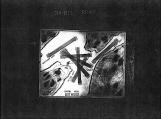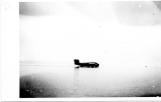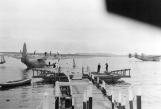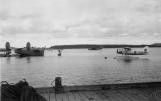1
At the beginning of World War II, the only passenger service to and from Europe was provided via Botwood by flying boats. The Royal Canadian Air Force (RCAF) took over, enlarged, and operated it partially for the benefit of American and British commercial companies maintaining a flying boat service to Britain.It was outfitted as a Royal Air Force Base accommodating the coastal defense anti-submarine patrol squadron using PBY-5A Canso Amphibians. A large concrete slipway and two hangars (the hangars were taken down in 1948) were constructed at the facility. Also, a Royal Air Force Squadron was stationed at Botwood in June of 1940. On April 3, 1941 an agreement was made to transfer the control of the airbase at Botwood to the Government of Canada (M. H. M. Mackinnen, 1946).
In 1943, by agreement between Canada and Newfoundland, Canada handed over some of the Anti Aircraft Battery buildings to provide accommodations and a restaurant for passengers and crews on the transatlantic service. The buildings were operated by British Overseas Airways Corporation (BOAC) and became known as Caledonia Camp, named for the Imperial Airways flying boat that made the first experimental crossing of the Atlantic in 1937. BOAC accepted the buildings as they were and the Department of National Defence charged no rent. The camp was jointly financed by the United Kingdom and Newfoundland.
Daily, the giant airliners of the BOAC, Pan American and Export Airlines circled the calm waters of Botwood harbour. Their passengers disembarked at the pier sacred to the RCAF during the years when its dawn patrol was writing history and helping win the Battle of the Atlantic. Airliner passengers were driven to the rest in luxury at Caledonia Camp during the one and a half hour stop while their plane was being refueled. At Caledonia Camp, the Caribou Club complete with bar, and up-to-date restaurant and other facilities, helped passengers pass the time in comfort and pleasure (Blackmore, 1946).
Ernie Lund, Senior Flying Control Officer (Operations Officer) was stationed in Botwood in 1944. He was charged with the responsibility of all aircraft landing and taking off from Botwood, including civilian and military aircraft. The 116 Squadron was the controlling agent for the movement. Mr. Lund's job was to make sure that things ran smoothly and to see that there was no conflict between military and civil operations. Besides him, there were half a dozen officers and 15-20 airmen in charge of the control tower, the crash boat, and the general operation. Mr. Lund was also responsible for the landing paths map for aircraft [on display at the Botwood Heritage Center.]
Mr. Lund stated that the base was very active. At first, with daylight flying only, and then the U.S. Naval Air Force Service was flying Coronados (big multi-engine flying boats) through day and night. Operations were changed to a very heavy night schedule and crews were on duty 24 hours a day.
When asked what he thought of Botwood today, Mr. Lund replied:
I went down to the base, saw Killick Island,and all that's left now is the path and the slipway. A little saddened because here was a bay that was so full of life and people, airplanes and happenings, everything going and coming, but it brought back a lot of memories. And I'd say all of them good! (Heath, 1991)
Frank Howell of the 102 Eastern Air Command Marine Squadron was also stationed in Botwood in 1944. When he first landed he was very impressed by the activity of flying aircraft. One of his duties was to lay out flare paths for the planes coming in from their reconnaissance over the ocean. In reminiscing he states:
You know it was a great thrill to watch the aircraft take off, and they depended on the Airbase Marine Squadron to get them back in. It was always a joy to get them back in. But I am disappointed that they didn't preserve at least one building on the tarmac, one hangar or something (Heath, 1991).






